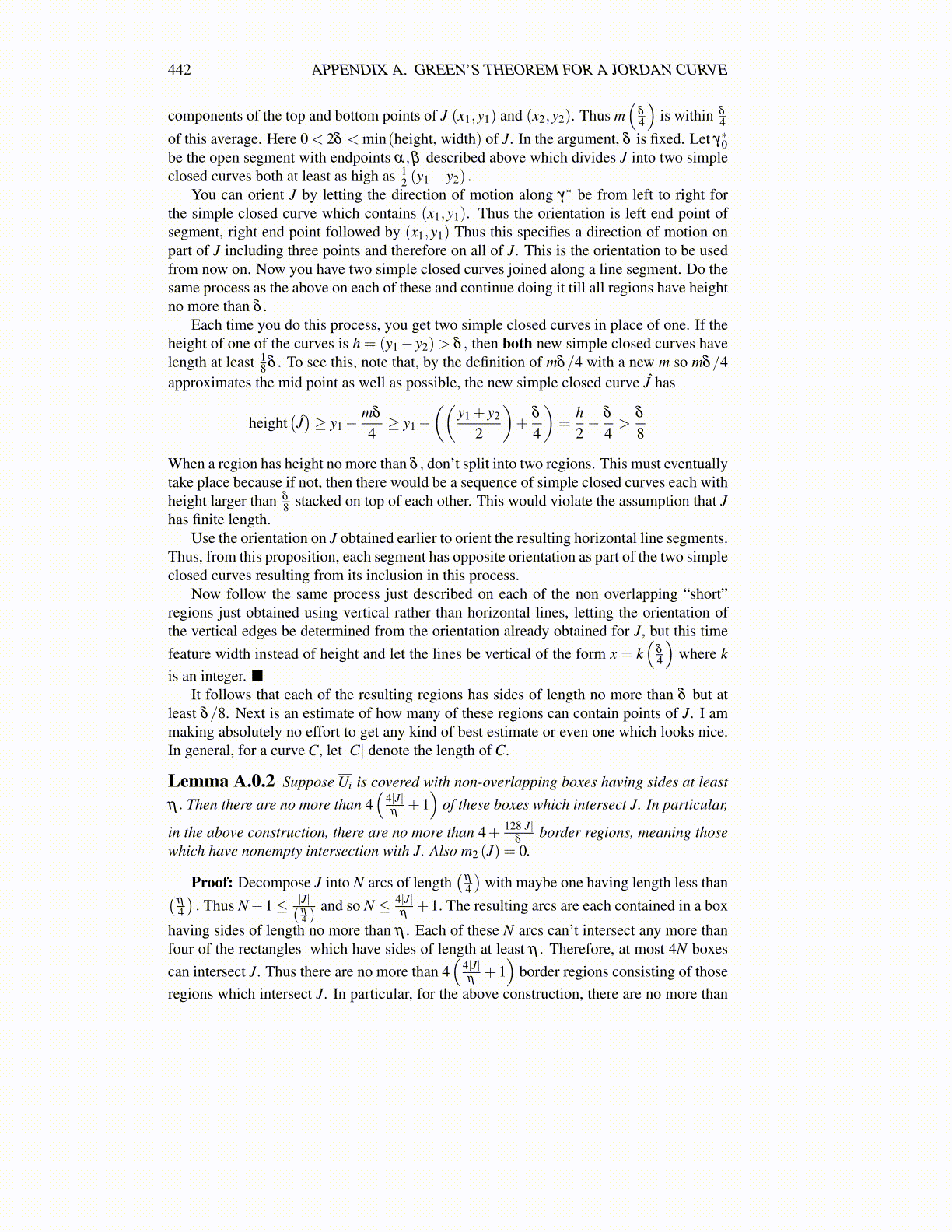
442 APPENDIX A. GREEN’S THEOREM FOR A JORDAN CURVE
components of the top and bottom points of J (x1,y1) and (x2,y2). Thus m(
δ
4
)is within δ
4
of this average. Here 0 < 2δ < min(height, width) of J. In the argument, δ is fixed. Let γ∗0be the open segment with endpoints α,β described above which divides J into two simpleclosed curves both at least as high as 1
2 (y1− y2) .You can orient J by letting the direction of motion along γ∗ be from left to right for
the simple closed curve which contains (x1,y1). Thus the orientation is left end point ofsegment, right end point followed by (x1,y1) Thus this specifies a direction of motion onpart of J including three points and therefore on all of J. This is the orientation to be usedfrom now on. Now you have two simple closed curves joined along a line segment. Do thesame process as the above on each of these and continue doing it till all regions have heightno more than δ .
Each time you do this process, you get two simple closed curves in place of one. If theheight of one of the curves is h = (y1− y2)> δ , then both new simple closed curves havelength at least 1
8 δ . To see this, note that, by the definition of mδ/4 with a new m so mδ/4approximates the mid point as well as possible, the new simple closed curve Ĵ has
height(Ĵ)≥ y1−
mδ
4≥ y1−
((y1 + y2
2
)+
δ
4
)=
h2− δ
4>
δ
8
When a region has height no more than δ , don’t split into two regions. This must eventuallytake place because if not, then there would be a sequence of simple closed curves each withheight larger than δ
8 stacked on top of each other. This would violate the assumption that Jhas finite length.
Use the orientation on J obtained earlier to orient the resulting horizontal line segments.Thus, from this proposition, each segment has opposite orientation as part of the two simpleclosed curves resulting from its inclusion in this process.
Now follow the same process just described on each of the non overlapping “short”regions just obtained using vertical rather than horizontal lines, letting the orientation ofthe vertical edges be determined from the orientation already obtained for J, but this timefeature width instead of height and let the lines be vertical of the form x = k
(δ
4
)where k
is an integer. ■It follows that each of the resulting regions has sides of length no more than δ but at
least δ/8. Next is an estimate of how many of these regions can contain points of J. I ammaking absolutely no effort to get any kind of best estimate or even one which looks nice.In general, for a curve C, let |C| denote the length of C.
Lemma A.0.2 Suppose Ui is covered with non-overlapping boxes having sides at leastη . Then there are no more than 4
(4|J|η
+1)
of these boxes which intersect J. In particular,
in the above construction, there are no more than 4+ 128|J|δ
border regions, meaning thosewhich have nonempty intersection with J. Also m2 (J) = 0.
Proof: Decompose J into N arcs of length(
η
4
)with maybe one having length less than(
η
4
). Thus N−1≤ |J|
( η
4 )and so N ≤ 4|J|
η+1. The resulting arcs are each contained in a box
having sides of length no more than η . Each of these N arcs can’t intersect any more thanfour of the rectangles which have sides of length at least η . Therefore, at most 4N boxescan intersect J. Thus there are no more than 4
(4|J|η
+1)
border regions consisting of thoseregions which intersect J. In particular, for the above construction, there are no more than